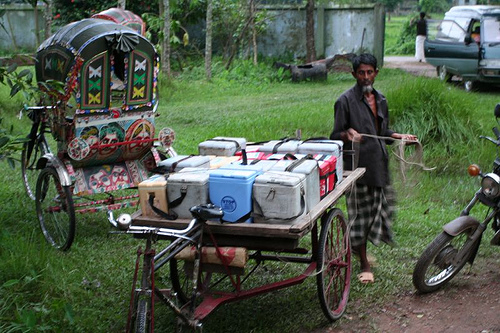A Simple Method of Vaccine Freeze Protection
Vaccines are temperature sensitive; They must be kept cold, but should not freeze. When vaccines are transported in the field they are placed in insulated carriers along with frozen ice packs. If these ice packs are below freezing and come in close contact to the vaccines they could freeze the vaccines.
We have been looking at some simple measures to prevent ice packs from freezing vaccines. One method incorporates placing several layers of wet towels between the vaccines and the ice packs. “Coolth” is then absorbed by the towels when the water changes phase, instead of the vaccines. This process can absorb a large amount of “coolth” per unit weight of water in the towel. The heat capacity of ice is 0.5 Btu/lb./Fº while the heat absorbing capacity of water is 144 Btu/lb as it changes phase.
When subzero ice packs are placed against the towel, a layer of ice forms on the cold side of the towel protecting the vaccines. After a number of hours this ice will melt and the wet towel will remain between the vaccines and the ice packs. The wet towel has a low R-value so there will be good thermal contact between the vaccines and the ice packs. Good thermal contact will maximize the length of time the vaccines remain below 10 deg C.
Another technique is to place insulation between the ice packs and the stored vaccines to prevent freezing. With this technique there will be a bigger temperature difference between the vaccines and the ice packs. This will increase the storage temperature of the vaccines. In hot weather the vaccines could then become too warm. This technique will also reduce the time the vaccines stay at an acceptable temperature.
With the wet towel methodology initial experiments indicate good freeze protection of the vaccines. This technique could easily be tested by placing a thermometer against the protected side of the towel with sub zero ice packs on the other side.
We would appreciate any comments you have on this process.
Comments are closed.




Hi there,
We are in the process of performing some simple experiments similar to those you describe in your blog. We are looking to try dry and wet towel, bubble wrap, newspaper and no wrapping. Just wanted to get in touch in case you wanted to share any ideas – we’d be happy to share the results of our pilot study.
Cheers,
Penny